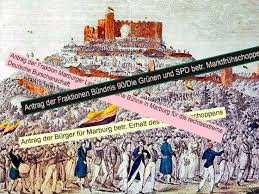Όταν το καλοκαίρι του 1967 η χούντα των συνταγματαρχών συνέλαβε τον Μίκη Θεοδωράκη για την αντιδικτατορική του δράση, τα νέα ταξίδεψαν σε όλον τον κόσμο. Ο Μίκης ήταν ήδη θρύλος της μουσικής, η φωνή των αγώνων για ελευθερία και δημοκρατία. Τα νέα έφτασαν ακόμη και στο μικρό Γκαίρλιτς της ανατολικής Γερμανίας, στα γερμανοπολωνικά σύνορα. Ο Κλάους Ντίτερ Τιτζ, σήμερα 63 ετών και τότε φοιτητής Ιατρικής, θυμάται την πρώτη φορά που άκουσε τον ήχο του μπουζουκιού στα τραγούδια του Θεοδωράκη. «Το ραδιόφωνο της Λαοκρατικής Δημοκρατίας (DDR) έπαιζε τραγούδια του Θεοδωράκη σε ένδειξη αλληλεγγύης», είπε στη Süddeutsche Zeitung. Σύντομα όμως σταμάτησε να τα μεταδίδει γιατί απέπνεαν υπερβολικά μεγάλη δόση ελευθερίας για τα δεδομένα της DDR.
H αγάπη του νεαρού φοιτητή για τη μακρινή χώρα της Ακρόπολης και του Αιγαίου δεν σταμάτησε. Αντίθετα αναζωπυρώθηκε. Μάλιστα παρά τη λογοκρισία του ανατολικογερμανικού καθεστώτος προσπάθησε να στείλει και μια επιστολή σε ραδιόφωνο της Αθήνας, γραμμένη στα ελληνικά, τα οποία έμαθε από ένα παλιό ρωσικό σύγγραμμα. Πίστευε ότι δεν θα τον πιάσουν, κι όμως. Σύντομα βρέθηκε υπόλογος για το επίμαχο γράμμα στο Πολωνικό Κέντρο Πληροφοριών της Λειψίας. Δεν ήταν τυχαίο. Οι Πολωνοί γνώριζαν ελληνικά και ήταν καλά εξοικειωμένοι με την ελληνική μουσική, χάρη στους Έλληνες κομμουνιστές που είχαν καταφύγει στην Πολωνία μετά την ήττα τους στον ελληνικό εμφύλιο.
Μια χωρισμένη πόλη με ένα άγνωστο ελληνικό παρελθόν
Το Ζγκορζέλετς ήταν πριν από τον Β' Παγκόσμιο Πόλεμο το ανατολικό τμήμα του Γκαίρλιτς. Η πόλη χωρίστηκε στα δύο το 1945, μετά το τέλος του πολέμου. Το Ζγκορζέλετς προσαρτήθηκε στην Πολωνία και το Γκαίρλιτς συνέχισε να υπάγεται στην Αν. Γερμανία. Ποια η σχέση όμως της μακρινής αυτής περιοχής με την Ελλάδα; Μετά το τέλος του ελληνικού εμφυλίου τον Οκτώβριο του 1949, 14.000 Έλληνες κομμουνιστές βρήκαν καταφύγιο στην Πολωνία, οι περισσότεροι στο Ζγκορζέλετς. Μάλιστα πολλοί το αποκαλούσαν «Republika Grecka».
Όταν άρχισαν να αντιλαμβάνονται ότι η επιστροφή στα πάτρια εδάφη θα καθυστερούσε πολύ, οι Έλληνες εξόριστοι άρχισαν να μαθαίνουν πολωνικά και να ασπάζονται ακόμη και τον καθολικισμό. Μόνο στοιχείο που κράτησαν άθικτο από το παρελθόν ήταν η ελληνική μουσική και τα ελληνικά γλέντια. Με τα χρόνια αφομοιώθηκαν στην πολωνική κοινωνία.Όμως δεν ήταν οι μόνοι Έλληνες στην περιοχή, θυμάται ο Κλάους Ντίτερ Τιτζ. Αν και το Γκέρλιτς χωριζόταν από το Ζγκορζέλετς μόνο από τον ποταμό Νάισε, οι Έλληνες του πολωνικού τμήματος δεν είχαν επαφές με την ανατολικογερμανική πόλη. Κι όμως, και εκεί, υπήρχαν ξεχασμένοι Έλληνες, εκτοπισμένοι μιας άλλης εποχής. Αυτό μαρτυρεί άλλωστε και η παλιά ελληνική εφημερίδα «Τα Νέα του Γκέρλιτς» από το 1916.
Από το μακεδονικό μέτωπο στο Γκέρλιτς το 1916
Πολύ πριν από τον εμφύλιο, στην καρδιά του Α' Παγκοσμίου Πολέμου αλλά και στον απόηχο του εθνικού διχασμού μια άλλη γενιά Ελλήνων στρατιωτών είχε σταλεί, κατόπιν μιας αμφιλεγόμενης συμφωνίας μεταξύ της Ελλάδας, της Αντάντ και των γερμανοβουλγαρικών στρατευμάτων, από το μακεδονικό μέτωπο στο Γκαίρλιτς της Σαξονίας. Πάνω από 6500 στρατιώτες του Δ' Σώματος Στρατού έφτασαν με τρένο από τη βόρεια Ελλάδα σε ένα στρατόπεδο του Γκαίρλιτς. Οι κάτοικοι της πόλης τους υποδέχθηκαν με στρατιωτικά εμβατήρια, εορταστικές γιρλάντες και καλωσόρισμα στα ελληνικά. Στην πραγματικότητα βέβαια αυτή η υποδοχή δεν ήταν παρά κομμάτι της γερμανικής προπαγάνδας, αφού οι Έλληνες στρατιώτες είχαν μεταφερθεί εκεί ως ιδιότυποι αιχμάλωτοι πολέμου με κάποια προνόμια, λόγω της σχέσης του τότε Βασιλιά Κωνσταντίνου με τον γερμανό Κάιζερ. Όπως αναφέρει ο ερευνητής Γεράσιμος Αλεξάτος που έχει ασχοληθεί διεξοδικά με την περίπτωση, οι Έλληνες στρατιώτες μπορούσαν να κυκλοφορούν στην πόλη, ωστόσο κάθε βράδυ επέστρεφαν απαρέγκλιτα στο στρατόπεδο. Επίσης δεν μπορούσαν να εγκαταλείψουν το γερμανικό έδαφος.
Την περίοδο του μεσοπολέμου πολλοί εξ αυτών σιγά σιγά εντάχθηκαν όμως στη ζωή της πόλης, κάποιοι έπιασαν δουλειά, άλλοι παντρεύτηκαν. Αυτά αφηγείται και η Χίλντεγκαρντ Χάλαρη, σήμερα 92 ετών, απόγονος Έλληνα στρατιώτη που είχε φτάσει στο Γκαίρλιτς. Πολλές είναι οι προσωπικές ιστορίες σαν αυτή της Χίλντεγκαρντ Χάλαρη, ενώ υπάρχουν ακόμη άνθρωποι που αναζητούν ίχνη αγνοούμενων μελών των οικογενειών τους στο Γκαίρλιτς.
Η ιστορία των Ελλήνων του Γκαίρλιτς αλλά και του Ζγκορζέλετς είναι μοναδική. Έλληνες εκτοπισμένοι, αχμάλωτοι κι εξόριστοι, έρμαια δύο τραγικών σελίδων της ελληνικής ιστορίας, βρέθηκαν κατά τύχη σε διαφορετικές ιστορικές περιόδους στην ίδια ουσιαστικά πόλη, η οποία επίσης είχε τη δική της τραγική ιστορία. Με ένα ποτάμι να τους χωρίζει, οι στρατιώτες του Δ' Σώματος Στρατού και οι εξόριστοι του εμφυλίου έμειναν δίπλα-δίπλα, χωρίς να γνωρίζουν οι μεν την ιστορία των δε. Κι όλα αυτά πολύ πριν φτάσουν στη Γερμανία οι πρώτοι «Gastarbeiter» τη δεκαετία του '60.
SZ, Kριστιάνε Σλέτσερ / Δήμητρα Κυρανούδη (DW)
















 established pre-Christian festival, and was known as "Litha" in some
cultures. As was their usual custom, the Christian church turned this
existing festival into a religious feast day, and the June 24
festivities soon became those of John the Baptist.
established pre-Christian festival, and was known as "Litha" in some
cultures. As was their usual custom, the Christian church turned this
existing festival into a religious feast day, and the June 24
festivities soon became those of John the Baptist. 

























